Contemporary Church History Quarterly
Volume 26, Number 3 (September 2020)
Review of Manfred Gailus, Friedrich Weißler. Ein Jurist und bekennender Christ im Widerstand gegen Hitler (Göttingen: Vandenhoeck & Rupprecht, 2017). 316 pages, with illustrations and an appendix with documentation. ISBN 978-3-525-30109-8.
By Victoria J. Barnett, United States Holocaust Memorial Museum (Retired)
Manfred Gailus (who is one of the editors of this quarterly review) has published several studies of little-known and under-examined individuals in the German Protestant churches under National Socialism, including Helmut Hesse, Elisabeth Schmitz, and other Protestant women who resisted Nazi racial policy. These books are not only detailed studies of what dignity and heroism in Nazi Germany looked like. They reveal how marginalized such people were in their own times and all too often in the historiography.[1]
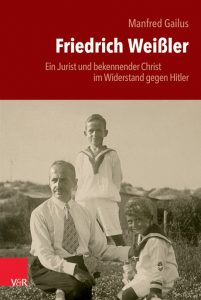 Friedrich Weißler is another such figure. A legal advisor to the Confessing Church, he is usually mentioned (if at all) in his connection to the 1936 Confessing Church memorandum (Denkschrift) to Adolf Hitler. Tortured and beaten to death in Sachsenhausen in February 1937, Weißler was the only person to be killed as a result of the memorandum. Not coincidentally, he was also the only “Volljude” involved. This 2017 book by Manfred Gailus is a gripping biography of a courageous man and a well-documented account of the genesis and aftermath of the memorandum. (Gailus is the first author to examine the papers that were in the family possession.)
Friedrich Weißler is another such figure. A legal advisor to the Confessing Church, he is usually mentioned (if at all) in his connection to the 1936 Confessing Church memorandum (Denkschrift) to Adolf Hitler. Tortured and beaten to death in Sachsenhausen in February 1937, Weißler was the only person to be killed as a result of the memorandum. Not coincidentally, he was also the only “Volljude” involved. This 2017 book by Manfred Gailus is a gripping biography of a courageous man and a well-documented account of the genesis and aftermath of the memorandum. (Gailus is the first author to examine the papers that were in the family possession.)
Weißler was raised in a secular and patriotic Jewish home. His father was a lawyer who was such a conservative nationalist that he committed suicide in the wake of the Versailles Treaty. Weißler studied and began to practice law during the 1920s, married a Protestant pastor’s daughter, and had two sons. Although he certainly encountered antisemitism in this first decade of his career, the Weimar years were generally happy ones professionally and personally. He moved steadily ahead in his career and became director of a legal journal; he also published books and articles on various aspects of the law. In 1932 he was appointed director of the regional court in Magdeburg. The Weißler family moved there in January 1933.
Within days of the Nazi ascent to power his life changed dramatically. Weißler issued a fine against a young SA man accused of violence who had appeared in court in uniform. The local Nazi press immediately targeted the “Jewish” judge. In an ugly incident local SA and Stahlhelm members pushed their way into the court building and hung a swastika flag from the balcony facing the town square. They then dragged Weißler to the balcony and forced him to salute the swastika flag. A few days later Weißler was suspended from his position, and in July he lost his position under the new civil service laws. Under Nazi racial laws he was a “Volljude.” In September the family, including Weißler’s elderly mother, moved to Berlin.
Weißler was 42 years of age. He had a very small pension and the family’s assets were modest. Having joined the Protestant church during the 1920s, in 1934 he became a member of the Confessing Church and developed close ties to the most radical circles in Dahlem. His legal expertise now became useful to the Confessing Church leadership as they navigated the realities of Reich church politics and Nazi law.
As in his other books, Gailus documents the antisemitism that was all too present in Confessing Church circles. It was something that Weißler encountered repeatedly and personally. The portrait that emerges is of a man who was characteristically reserved but outspoken and unafraid to confront antisemitism. After Pastor Walter Thieme of the Stadtmission defended Adolf Stoecker’s warnings against the “influence of the Jewish spirit on the life of our Volk,” Weißler wrote Thieme that he could “summon no understanding for your behavior.” He also critiqued members of the Deutsche Christen—a courageous risk for someone in his position.
All this took its toll. There are poignant examples of friends and colleagues who abandoned or turned against the Weißler family. Having received an antisemitic letter from one such “friend” Weißler noted that he was replying “only in consideration that you like so many others have succumbed to the general psychosis of this era, and given that which we previously shared.”
This general antisemitism is an important context for Gailus’s account of the 1936 memorandum to Hitler. Like all Confessing Church protests, it was a mixed bag. A small group within the Confessing Church had been urging the leadership to issue a clear public protest against the regime’s antisemitic measures; in the wake of the September 1935 Nuremberg laws these efforts gained new momentum. Although most Confessing Christians were focused primarily on church members (so-called “Christian non-Aryans”) there were others (notably Elisabeth Schmitz) who wanted the church leadership to speak decisively about the persecution of all German Jews.
These efforts led to the Confessing Church leadership’s decision to issue a memorandum and send it directly to Adolf Hitler. The decision coincided with growing divisions within the church opposition between more radical voices like Martin Niemöller and Dietrich Bonhoeffer and the church’s more compromising leaders. The memorandum was the work of a committee and like many such documents it had been considerably watered down by the time it was completed. The result was primarily an expression of the Confessing Church’s concerns about the Nazi regime’s pressures on the churches and the “dechristianization” of German society. It opened, for example, with a conciliatory expression of gratitude to Führer for defeating the threat of “bolshevism.”
The most notable section of the memorandum however condemned antisemitism in the most explicit wording that would ever be issued by the Confessing Church. It criticized the growing Nazi incitement of anti-Jewish hatred, particularly propaganda aimed at younger Germans, as “anti-Christian.” It went further, condemning the extrajudicial nature of Gestapo measures and the concentration camps, and warning against the “deification” of the Führer.
The memorandum was intended for Hitler’s eyes only and those involved were sworn to secrecy. Supposedly there were only three copies: a document personally delivered to the Reichskanzlei on June 4, 1936, by Pastor Walter Jannasch; a separate copy given to Birger Forell, pastor of the Swedish Church in Berlin; and another copy placed in the safe of the church chancellery in Berlin. It is not known whether Hitler ever even saw the memorandum; the Chancellor’s Office forwarded it to the Reich Church Ministry.
On July 15—two weeks before the opening of the Berlin Olympics—the New York Herald reported on the memorandum, and on July 23 the Basler Nachrichten published the entire document as an example of Protestant opposition to the Nazi regime. The story was also picked up by leading papers like the New York Times and the London Times.
Alarmed, the Confessing Church leadership immediately tried to find out who had leaked the memorandum. They focused on individuals with foreign press contacts, including Friedrich Weißler, who had advised throughout the planning of the memorandum. The others were Werner Koch, a seminarian who had studied with Dietrich Bonhoeffer in Finkenwalde, and Ernst Tillich, who had studied under Bonhoeffer in Berlin before abandoning his theological studies. Weißler admitted to the church leadership that he had given a copy of the memorandum to Tillich (who knew Koch and had ties to the foreign press).
Gailus methodically reconstructs the subsequent events. Weißler, Koch, and Tillich were arrested in October 1936, as was Dr. Heinrich Schmidt, a lawyer who worked for the Confessing Church. Schmidt was released after a short time, but the other three were interrogated throughout the fall of 1936. In the meantime the Confessing Church leadership distanced itself from the group and the memorandum. In a late October meeting it was Martin Niemöller who argued that the church had to distance itself completely from Weißler: “We owe it to the Confessing Church.”
In a damning letter to Heinrich Himmler in early February 1937 the Confessing Church leadership emphasized that Weißler had never held an official position in the Confessing Church and had served only in an informal capacity. Five days later the three men were transferred from the Gestapo prison in Berlin to Sachsenhausen. Koch and Tillich were imprisoned in a block doing forced labor and released after several months. On the orders of Sachsenhausen commandant Karl Koch, Weißler was placed in solitary confinement a different block of the camp. Six days later his wife received word that he was dead. Accompanied by Heinrich Schmidt, she went to the camp and was able to see that her husband’s face was swollen and badly bruised.
Even by Nazi standards, Weißler’s death was considered extrajudicial, and at the end of 1938 three Sachsenhausen guards were tried in the killing. It became clear from the court proceedings that Weißler had been badly beaten over the six days of his imprisonment before dying of his injuries, and equally clear, as Gailus notes, that the sole motive was “blind hatred” against Jews. Only one of the guards was sentenced, to one year in prison.
Gailus’ account acknowledges those members of the Confessing Church who did stand by Weißler throughout this ordeal—notably Hans Böhm and Fritz Müller. Franz Hildebrandt, a Confessing vicar affected by the racial laws who would soon flee himself to England, was also outspoken in Weißler’s defense. In the aftermath of his death, Hildebrandt and Heinrich Schmidt continued to help Weißler’s widow and family. Weißler’s eldest son Ulrich was able to emigrate to England in 1939 on the Kindertransport. His widow and other son remained in Germany, assisted financially by friends. Weißler’s elderly mother, who lived with the family, was deported to Theresienstadt in 1943 and died there shortly thereafter. Ironically, when Martin Niemöller was sent to Sachsenhausen in March 1938 as a “special prisoner” of the Führer, he was imprisoned in the same block in which Weißler had been murdered.
Gailus concludes this fine book with a reflective chapter on the continuing importance of these individual histories, even decades after the end of National Socialism. Readers of this journal will not need to be convinced of that, but I wish this book could be translated into English. The story of Friedrich Weißler is a crucial corrective for the all too frequent superficial understandings of the Confessing Church. I will add that reading this book in light of our current events in the United States, including the murders of Black men by the police and the rise in right-wing hatred and violence, was especially sobering.
Notes:
[1] I should note that the oral histories I conducted in Germany during the 1980s included interviews with Werner Koch and Heinrich Schmidt, both of whom were involved in the memorandum. Excerpts from both interviews, giving detailed accounts of the memorandum and Weißler’s death, were published in For the Soul of the People. Both interviews are now available to scholars in the collections of the United States Holocaust Memorial Museum (the transcript of the Schmidt interview, which was not taped, is being added): https://collections.ushmm.org/search/catalog/irn707864.

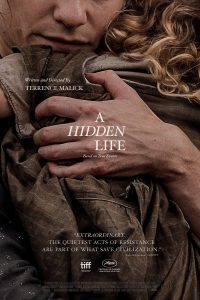 Malick is an atypical American director: he has protected his private life to the point of reclusiveness; his projects routinely consume several years; while he has made several critically-acclaimed films (his first film, Badlands; The Thin Red Line, about the Vietnam War; The Tree of Life, about immortality), he is both lauded and criticized for favouring themes and visual aesthetics over plot and narrative (see The Tree of Life). In fact, A Hidden Life delivers a more linear narrative than many of his films, with an identifiable beginning, middle, and end. It opens with Leni Riefenstahl’s Triumph des Willens, the famous aerial shot of clouds and a city gradually coalescing through the mist. Lasting only the first couple of minutes, and including splices from elsewhere in that famous 1934 documentary, such as the stunning panorama of the Nazi Party’s rally grounds, this is all Malick gives to the audience of Hitler’s climb to power and takeover of Austria and Czechoslovakia before plunging directly into the fall of 1939. Franz Jägerstätter (August Diehl) is married to Franziscka (“Fani”, Valerie Pachner), and has two small blonde-haired, blue-eyed daughters. They live in the Upper Austrian village of Sankt Radegund, not far from the German border (Bavaria). We watch them pause in their labour as unseen planes fly overhead, our only clue that the war has begun.
Malick is an atypical American director: he has protected his private life to the point of reclusiveness; his projects routinely consume several years; while he has made several critically-acclaimed films (his first film, Badlands; The Thin Red Line, about the Vietnam War; The Tree of Life, about immortality), he is both lauded and criticized for favouring themes and visual aesthetics over plot and narrative (see The Tree of Life). In fact, A Hidden Life delivers a more linear narrative than many of his films, with an identifiable beginning, middle, and end. It opens with Leni Riefenstahl’s Triumph des Willens, the famous aerial shot of clouds and a city gradually coalescing through the mist. Lasting only the first couple of minutes, and including splices from elsewhere in that famous 1934 documentary, such as the stunning panorama of the Nazi Party’s rally grounds, this is all Malick gives to the audience of Hitler’s climb to power and takeover of Austria and Czechoslovakia before plunging directly into the fall of 1939. Franz Jägerstätter (August Diehl) is married to Franziscka (“Fani”, Valerie Pachner), and has two small blonde-haired, blue-eyed daughters. They live in the Upper Austrian village of Sankt Radegund, not far from the German border (Bavaria). We watch them pause in their labour as unseen planes fly overhead, our only clue that the war has begun.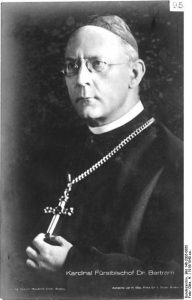
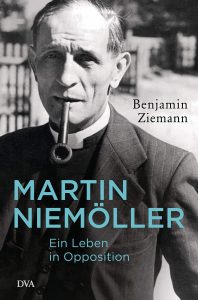 To this day, Martin Niemöller remains one of the most famous German churchmen of the twentieth century. He is regarded as an upright resistance fighter against Hitler, who testified to his stance with seven years of incarceration in concentration camps, as a preacher who admonished German “guilt” and as someone who had transformed from an imperial submarine commander of the First World War into a pacifist, who during the 1950s eloquently and powerfully opposed the Federal Republic of Germany’s Western alliance, its remilitarization, and nuclear weapons. Now, 35 years after Niemöller’s death in 1984, Benjamin Ziemann, Professor of Modern German History at the University of Sheffield and Fellow of the Royal Historical Society, cuts through the thicket of legend concerning Niemöller’s story and uncovers important strands of his life.
To this day, Martin Niemöller remains one of the most famous German churchmen of the twentieth century. He is regarded as an upright resistance fighter against Hitler, who testified to his stance with seven years of incarceration in concentration camps, as a preacher who admonished German “guilt” and as someone who had transformed from an imperial submarine commander of the First World War into a pacifist, who during the 1950s eloquently and powerfully opposed the Federal Republic of Germany’s Western alliance, its remilitarization, and nuclear weapons. Now, 35 years after Niemöller’s death in 1984, Benjamin Ziemann, Professor of Modern German History at the University of Sheffield and Fellow of the Royal Historical Society, cuts through the thicket of legend concerning Niemöller’s story and uncovers important strands of his life.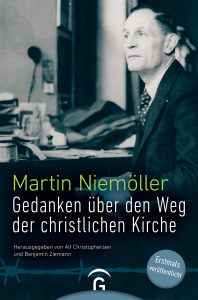 This book, edited by Alf Christophersen and Benjamin Ziemann, has given a surprising moment in Niemöller’s life its most thorough explication. It also offers readers an edited version of the handwritten manuscript Niemöller produced within a period of less than three months during his four years of solitary confinement in Sachsenhausen. His assessment of Catholicism versus Protestantism, a document which numbers over 200 pages in Niemöller’s hand, now comprises 150 printed pages in this book.
This book, edited by Alf Christophersen and Benjamin Ziemann, has given a surprising moment in Niemöller’s life its most thorough explication. It also offers readers an edited version of the handwritten manuscript Niemöller produced within a period of less than three months during his four years of solitary confinement in Sachsenhausen. His assessment of Catholicism versus Protestantism, a document which numbers over 200 pages in Niemöller’s hand, now comprises 150 printed pages in this book.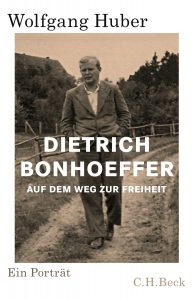 The structure of the book is not unduly distinctive, but it sets out clearly the overall argument and method. Huber’s Bonhoeffer is certainly a big and complex figure. He is also one full of contrasts and the author delights in framing and exploring them. An introductory section evokes the figure of Bonhoeffer as we might first encounter him in a variety of places, not least over the Great West Door of Westminster Abbey. There follows a section on Bonhoeffer’s background and early formation and then another three on his early work in the contexts of university and church life, the first situating him firmly in the landscapes of German thought, the second examining a theology of grace which was deeply rooted in the precepts of Lutheranism, and the third discussing the place of the Bible in a world of maturing historical criticism. Each of these sections present dualities which already defined so much in Bonhoeffer’s work (‘Individual spirituality or Society’; ‘The Church of the World or the Church of the Word’; ‘Acting justly and waiting for God’s own time’; ‘The Historical Jesus or the Jesus of Today’). The young Bonhoeffer is certainly very much at home in the intellectual landscapes of German Lutheranism but the emerging vision is an open one and there is no knowing where it will lead.
The structure of the book is not unduly distinctive, but it sets out clearly the overall argument and method. Huber’s Bonhoeffer is certainly a big and complex figure. He is also one full of contrasts and the author delights in framing and exploring them. An introductory section evokes the figure of Bonhoeffer as we might first encounter him in a variety of places, not least over the Great West Door of Westminster Abbey. There follows a section on Bonhoeffer’s background and early formation and then another three on his early work in the contexts of university and church life, the first situating him firmly in the landscapes of German thought, the second examining a theology of grace which was deeply rooted in the precepts of Lutheranism, and the third discussing the place of the Bible in a world of maturing historical criticism. Each of these sections present dualities which already defined so much in Bonhoeffer’s work (‘Individual spirituality or Society’; ‘The Church of the World or the Church of the Word’; ‘Acting justly and waiting for God’s own time’; ‘The Historical Jesus or the Jesus of Today’). The young Bonhoeffer is certainly very much at home in the intellectual landscapes of German Lutheranism but the emerging vision is an open one and there is no knowing where it will lead.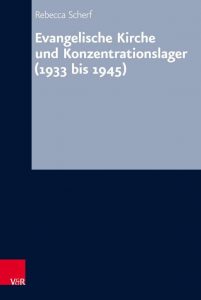 Rebecca Scherf’s study of the German Evangelical Church’s (GEC) responses to the concentration camps is a significant new contribution to the scholarship. While her main focus concerns Protestant clergy who were sent to concentration camps (she confined her study to concentration camps, so it does not include pastors who were in prisons), she has broadened her analysis to address three points of intersection between the GEC and the concentration camp system. The first concerns the relationship between regional churches and the Protestant chaplains who served in the early camps. The second examines the official church responses when clergy were sent to camps. The third looks at the experiences of those who were imprisoned in camps by drawing on contemporary documentation and subsequent memoirs. There are several appendixes with helpful graphs illustrating the number of clergy arrests by year (1935—when there were mass arrests of Confessing pastors due to a pulpit protest—was the peak), by camp, and by regional church. While most clergy who were sent to camps were held only briefly (indicating that the Nazi state intended such arrests as a form of intimidation), the number of arrests during the war grew and fewer were released. There is also a chronologically and geographically organized list of the Protestant clergy who were imprisoned.
Rebecca Scherf’s study of the German Evangelical Church’s (GEC) responses to the concentration camps is a significant new contribution to the scholarship. While her main focus concerns Protestant clergy who were sent to concentration camps (she confined her study to concentration camps, so it does not include pastors who were in prisons), she has broadened her analysis to address three points of intersection between the GEC and the concentration camp system. The first concerns the relationship between regional churches and the Protestant chaplains who served in the early camps. The second examines the official church responses when clergy were sent to camps. The third looks at the experiences of those who were imprisoned in camps by drawing on contemporary documentation and subsequent memoirs. There are several appendixes with helpful graphs illustrating the number of clergy arrests by year (1935—when there were mass arrests of Confessing pastors due to a pulpit protest—was the peak), by camp, and by regional church. While most clergy who were sent to camps were held only briefly (indicating that the Nazi state intended such arrests as a form of intimidation), the number of arrests during the war grew and fewer were released. There is also a chronologically and geographically organized list of the Protestant clergy who were imprisoned.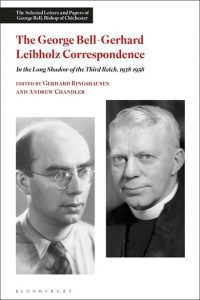 The volume opens with Bell’s September 1938 letter to Bonhoeffer assuring him of his willingness to help the Leibholzes. George Bell had been actively involved since 1933 in assisting refugees from Nazi Germany, including members of the Confessing Church who were affected by the Nazi laws. The early correspondence offers a detailed picture of the difficulties refugees faced even after they reached a safe country. They could not assume, of course, that they would remain in safety; Leibholz’s brother Hans and his wife managed to reach Holland, but committed suicide in 1940 after the German invasion. Added to this anxiety were financial concerns (Germany froze Leibholz’s assets when he fled, so they arrived in England with nothing), worries about the family they had left behind, existential concerns about employment and the future, and dealing with anti-German prejudice in England once the war began. In May 1940 Leibholz was interned as an “enemy alien” on the Isle of Man, along with a number of Confessing Church pastors and their wives. Bell managed to obtain his release in August 1940, after which the two men pursued the possibility that the Leibholzes might immigrate to the United States. With the assistance of Dietrich Bonhoeffer’s contacts in New York, Leibholz was offered and accepted an invitation to Union Theological Seminary in 1941, but by then the door had closed due to new U.S. restrictions on immigration.
The volume opens with Bell’s September 1938 letter to Bonhoeffer assuring him of his willingness to help the Leibholzes. George Bell had been actively involved since 1933 in assisting refugees from Nazi Germany, including members of the Confessing Church who were affected by the Nazi laws. The early correspondence offers a detailed picture of the difficulties refugees faced even after they reached a safe country. They could not assume, of course, that they would remain in safety; Leibholz’s brother Hans and his wife managed to reach Holland, but committed suicide in 1940 after the German invasion. Added to this anxiety were financial concerns (Germany froze Leibholz’s assets when he fled, so they arrived in England with nothing), worries about the family they had left behind, existential concerns about employment and the future, and dealing with anti-German prejudice in England once the war began. In May 1940 Leibholz was interned as an “enemy alien” on the Isle of Man, along with a number of Confessing Church pastors and their wives. Bell managed to obtain his release in August 1940, after which the two men pursued the possibility that the Leibholzes might immigrate to the United States. With the assistance of Dietrich Bonhoeffer’s contacts in New York, Leibholz was offered and accepted an invitation to Union Theological Seminary in 1941, but by then the door had closed due to new U.S. restrictions on immigration.